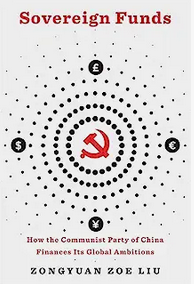Sovereign Funds: How the Communist Party of China Finances Its Global Ambitions by Zongyuan Zoe Liu is a rather detailed book but a fascinating insight into the evolution of China’s financial policy and its strategic investments using leveraged foreign exchange reserves. The book argues that China has created a new type of fund, Sovereign Leverage Funds, created through the use of complicated debt instruments. Unlike Sovreeign Wealth Funds, they do not require a stream of profits from an activity such as the export of commodities. “SLFs are a political-economic innovation because they are the product of the state leveraging its political and financial resources to make it possible to capitalize a fund,” which can then be invested overseas for startegic geopolitical purposes – the BRI. The SLFs can influence their portfolio investments through the use of voting rights – or a threat of disinvestment.
The first part of the book traces the origins of the arrangements in CHina’s historic opening up and accumulation of massice foreign exchange reserves. The Asian Financial crisis of 1997 was a key moment in determining the leadership to ensure China built up massive reserves: “Awakened by the severity of the crisis, CPC leaders realised dor the first time that national security could not be narrowly defined only by military competences … but must also include financial security.” (I was in Hong Kong as a journalist for the IMF/World Bank meetings held there in September 1997 – an amazing experience.) The 2008 crisis was another key moment. The existence of the SLFs has allso given China’s state owned enterprises a ready source of finance for overseas acquisitions and infrastructure investment, putting them at an advantage compared to their competitors.
The book then sets out a detailed account of the SLFs and their evolution through to the post-Covid period. It argues that liberal market economies should follow China’s example and set up their own SLFs to “act as white knight investors to defend strategic industries from unwanted foreign takeovers.” Challenges like investing in the green transition will require leverage, it argues. Such funds are institutions between state and market and “can be powerful tools for the practice of financial statecraft.”
There are loads of interesting details. For instance I had never realised that many of the cities authorised to be new economic zones after April 1990 were former treaty ports: “From the perspective of the Party, its revivial of China’s former treaty ports conveyed a message to the Chineses people: only the Party was capable of leading China’s broader economic revivial and redeeming the country from its prior century of humiliation.”
I know far too little about either international finance or Chinese politics to evaluate the book’s argument, but it seems reasonable. It also seems to be a rosy perspective, given what one reads about over-leverage domestically and problems with some BRI investments. As ever, the capacity of the CPC to take a strategic view is striking – especially in a country that sometimes seems governed from tweet to tweet. I’ve argued in a recent article for the use of long-term vehicles like soveriegn funds or investment banks to institutionalise learning in economic policy. I found the book fascinating and will look forward to reading some reviews by readers who do have the right expertise.

